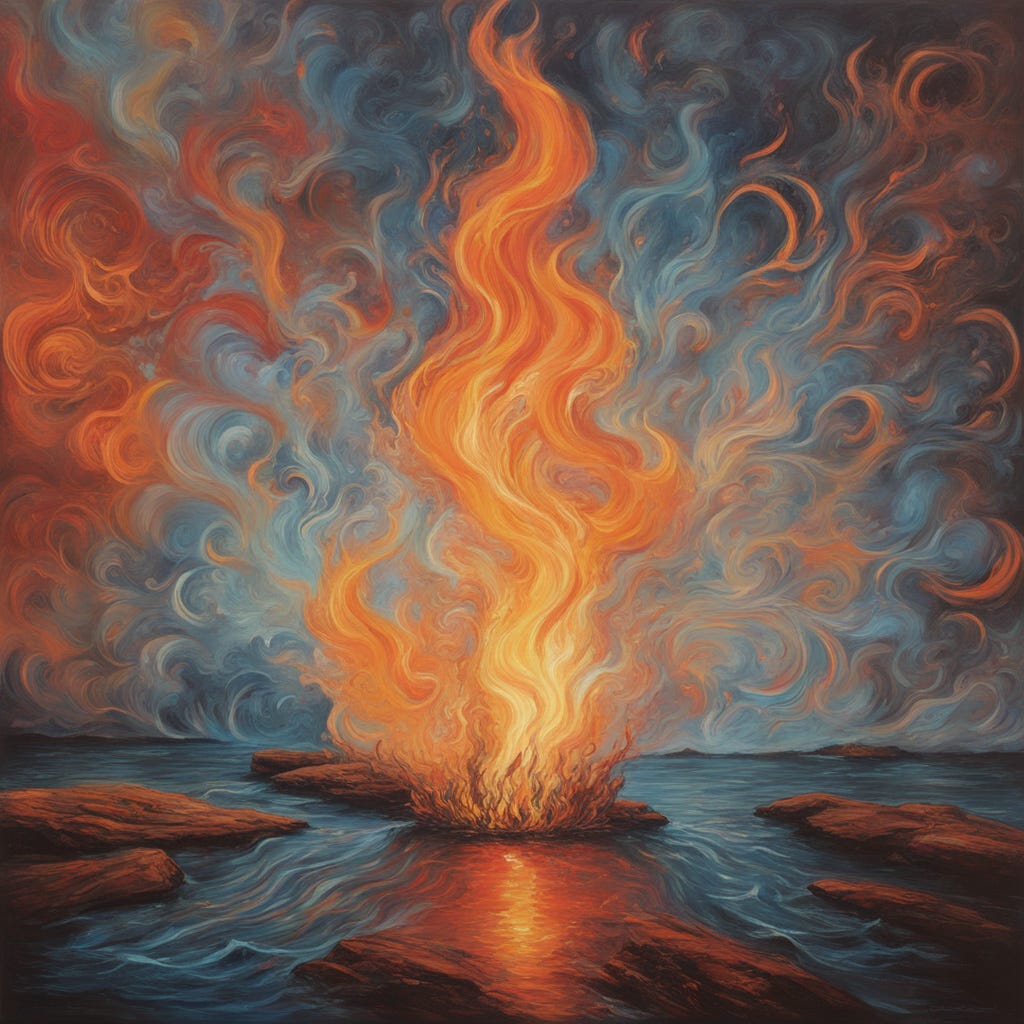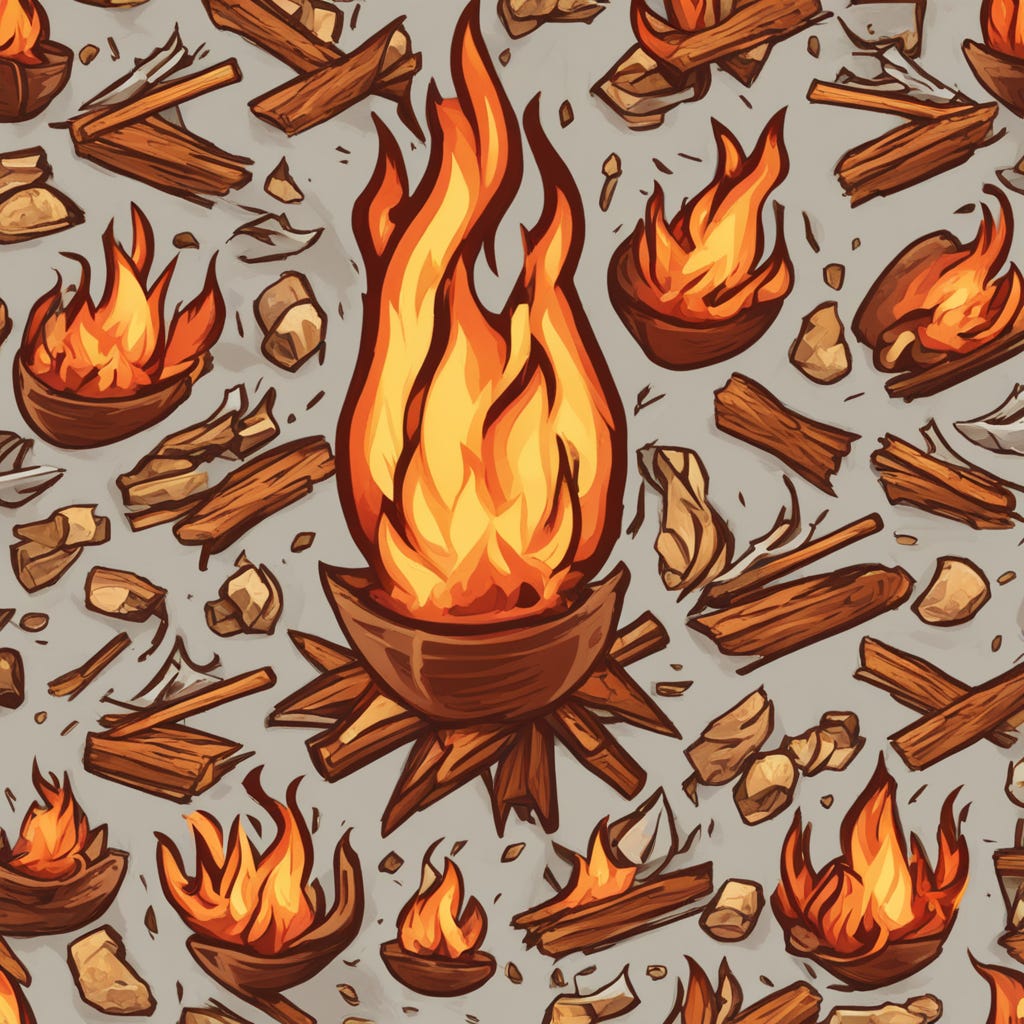Fueling Your Creative Fire: Managing Burnout and Ideas for Sustainable Projects
A Letter from Love (and My Internal Strategist)
Some years ago, I found myself in the middle of the Pine Barrens in New Jersey, crouched over a slab of cedar wood, madly pulling and pushing on a branch tied on both ends with a coarse string. The string was wrapped around a wooden stake, and I was stutteringly getting it to rotate into a small pile of wood shavings.
This was the standard entry course at Tom Brown’s School of Hunting and Tracking. I and 40 other people, were practicing the essential survival skill of fire-making with a bow drill.
Despite the six intensive days I spent at this wilderness survival school, straining my knees, shoulders, neck, and wrists rubbing wood together, I never managed to produce the coveted prize - a tiny, smoldering coal that could then be used to start an actual fire.
This desperate image of myself arose this morning as I was writing down yet another project idea that I knew I didn’t have the resources to manifest. It was as if all the notebooks, Google docs, and iPhone apps I had filled with scribblings over the years were attempts to catch sparks arising from the strike of a flint stone, but for which I had no way to transform into a larger flame.
It felt like a practice of resignation to capture wisps of divinity already knowing they may never come to pass. Despair started talking to me. What was the point? Would I never make it beyond the ideation phase? Would all my projects die on the vine, with only the tiniest fruits to show after years of growing for all the energy I put into them?
One of the best things to placate despair, I’ve found, is a Letter from Love, a practice I’ve been cultivating from Elizabeth Gilbert. It came through with this:
Dear Love, what would you have me know today?
.
.
.
Hello my sweetest little spinning top,
There are so many ideas in your mind - you want to offer so much to the world - it’s a beautiful quality. And sometimes this can get you into ‘should’ mode, which throws you into feelings of obligation, which leads to guilt, shame, self-judgment, and not enough-ness.
Dearest brilliant flame, each inspiration you have is a flicker that could grow into a flame. But for the spark to catch and grow steadily, we must have fuel to sustain it. If we want to be more than match heads continually striking and burning out, we need to understand how our fuel reserves work - how much is available to us now? What kind of fuel do we need for what kind of fire - a small one to light the way? A medium one to keep us warm over the night? A heartily crackling hearth to sustain a community over a generation?
Dear brave glow of the night, let us consider for a moment how much wood we need to gather before we start, which skills we need to tend to the flame, and under which conditions we are building the fire.
A fire built on a dry, gentle day with an abundance of tinder, twigs, logs, and a match will be a different experience from building one in the rain, with damp wood, and only a bow drill. Both are possible, but one requires much more skill, effort, time, and luck, and may not ever become a roaring furnace.
It’s crucial to be connected to the environmental conditions, and the internal state of ourselves when we set out to make a fire. If we are unclear, we could expend a lot of effort and time in the wrong moment trying to make something improbable happen.
We may also need to adjust our objectives based on external and internal conditions - a roaring fire is not always possible - nor is it necessarily desirable. It depends on what you need it for. Sometimes we may want to kindle a fire mostly to show that we can do it. We may feel we need to prove our skills, determination, and ability to overcome unfavorable conditions by throwing ourselves whole-heartedly into making this fire. No matter what, we will build a crackling flame, and show everyone that we can do what others can’t. We want to show ourselves as extraordinary and be seen as such.
Dearest fire-maker, let us take a breath together. And another. Let us feel how this way of being is energizing but streaked with desperation. It is driven in some important ways by a need for things to be not as they are, but how we think they should be.
My blazing little glow-bug, let us switch now to our strategic selves, and consider:
Fire-making Principles for Starting Projects, and Sustaining Them
When we make a fire, we need:
A base upon which the flame sits to insulate it from the coldness and wetness of the ground
A spark
Tinder to transform the spark into a tiny flame that can feed the kindling
A range of kindling - small, medium, and large - to carry the tiny flameand help it to steadily grow
Logs for the fire once it is large enough to consume them
A mistake that many make when building a fire is to go straight from spark to log, without providing the small, growing ember the right sized kindling to help it climb incrementally in size.
A small flame needs to be fed the same way a small organism needs - it cannot digest an entire log before it digests small twigs. If a fire is not able to move gradually from smaller fuel to larger fuel, it will extinguish itself.
Things that can affect the viability of the fire:
Kindling that is unsuitable for the small flame to consume - too damp, too big, not the right of wood
The construction of the fire is not well-thought-out, and the fire cannot grow steadily larger because the materials are not ready when the fire needs to be fed, or are the wrong materials
The conditions are unfavorable for the flame to fully expand - it is too wet, too cold, too windy, there is not enough airflow, and the fire could burn itself out
Dearest creative heart, every spark of an idea you have is sacred - it is a complete universe just for the fact that it exists. And yet not every spark will become a flame at the moment it arises. Take care of your energy, and be mindful and measured in how you spend it.
Love
.
.
.
After Love spoke to me, I thought about what it really means to grow out of and away from burnout culture. It is my intention to live into a way of being that does not require me to constantly be exhausting my sparks to be able to move forward. And I no longer have the same need to prove myself as I once did. This means that not every spark of an idea will be followed up on. I will not try to build every flame into a fire because I cannot maintain so many hearths with the resources currently available to me.
But what I can do to build a sustained fire that will also in time sustain me with its warmth, is to give good consideration to its construction before I begin.
What are the resources available to me now? How does my time availability look? What are my physical, mental, and emotional reserves? How do I anticipate these reserves being tapped into, or recharged with what I can foresee coming around the corner?
What environmental conditions am I working under? How much energy and patience do I have, and what are my needs for making this fire? Where, when, and from whom do I collect my fuel? How do I anticipate how long this fire is going to need me to support it, and what does it need in time to be able to sustain itself? How long will I want this fire to keep burning?
And very importantly: how will I celebrate, once my fire is going strong? Who would I like to invite to share the warmth of my fire, and what songs would I like to sing as I am basking in it?
.
.
.








